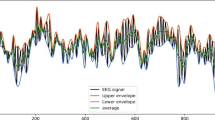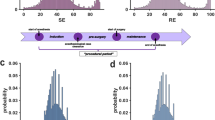Abstract
The electroencephalogram (EEG) has been widely applied in the assessment of depth of anesthesia (DoA). Recent research has found that multi-scale EEG analysis describes brain dynamics better than traditional non-linear methods. In this study, we have adopted a modified sample entropy (MSpEn) method to analyze anesthetic EEG series as a measure of DoA. EEG data from a previous study consisting of 19 adult subjects undergoing sevoflurane anesthesia were used in the present investigation. In addition to the modified sample entropy method, the well-established EEG indices approximate entropy (ApEn), response entropy (RE), and state entropy (SE) were also computed for comparison. Pharmacokinetic/pharmacodynamic modeling and prediction probability (P k ) were used to assess and compare the performance of the four methods for tracking anesthetic concentration. The influence of the number of scales on MSpEn was also investigated using a linear regression model. MSpEn correlated closely with anesthetic effect. The P k (0.83 ± 0.05, mean ± SD) and the coefficient of determination R 2 (0.87 ± 0.21) for the relationship between MSpEn and sevoflurane effect site concentration were highest for MSpEn (P k : RE = 0.73 ± 0.08, SE = 0.72 ± 0.07, ApEn = 0.81 ± 0.04; R 2: RE = 0.75 ± 0.08, SE = 0.64 ± 0.09, ApEn = 0.81 ± 0.10). Scales 1, 3 and 5 tended to make the greatest contribution to MSpEn. For this data set, the MSpEn is superior to the ApEn, the RE and the SE for tracking drug concentration change during sevoflurane anesthesia. It is suggested that the MSpEn may be further studied for application in clinical monitoring of DoA.










Similar content being viewed by others
References
Johansen JW, Sebel PS, Sigl JC. Clinical impact of hypnotic-titration guidelines based on EEG bispectral index (BIS) monitoring during routine anesthetic care. J Clin Anesth. 2000;12(6):433–43.
Bruhn J, Myles PS, Sneyd R, Struys MM. Depth of anaesthesia monitoring: what’s available, what’s validated and what’s next? Br J Anaesth. 2006;97(1):85–94. doi:10.1093/bja/ael120.
Jameson L, Sloan T. Using EEG to monitor anesthesia drug effects during surgery. J Clin Monit Comput. 2006;20(6):445–72.
Zikov T, Bibian S, Dumont GA, Huzmezan M, Ries CR. Quantifying cortical activity during general anesthesia using wavelet analysis. IEEE T Bio Med Eng. 2006;53(4):617–32. doi:10.1109/Tbme.870255.
Rampil IJ. A primer for EEG signal processing in anesthesia. Anesthesiology. 1998;89(4):980–1002.
Bruhn J, Ropcke H, Rehberg B, Bouillon T, Hoeft A. Electroencephalogram approximate entropy correctly classifies the occurrence of burst suppression pattern as increasing anesthetic drug effect. Anesthesiology. 2000;93(4):981–5. doi:10.1097/00000542-200010000-00018.
Sörnmo L, Laguna P. Bioelectrical signal processing in cardiac and neurological applications. Boston: Elsevier; 2005.
Maksimow A, Snapir A, Sarkela M, Kentala E, Koskenvuo J, Posti J, Jaaskelainen SK, Hinkka-Yli-Salomaki S, Scheinin M, Scheinin H. Assessing the depth of dexmedetomidine-induced sedation with electroencephalogram (EEG)-based spectral entropy. Acta Anaesthesiol Scand. 2007;51(1):22–30. doi:10.1111/j.1399-6576.2006.01174.x.
Cao YH, Tung WW, Gao JB, Protopopescu VA, Hively LM. Detecting dynamical changes in time series using the permutation entropy. Phys Rev E. 2004;70(4):46217. doi:10.1103/Physreve.70.046217.
Li X, Polygiannakis J, Kapiris P, Peratzakis A, Eftaxias K, Yao X. Fractal spectral analysis of pre-epileptic seizures in terms of criticality. J Neural Eng. 2005;2(2):11–6. doi:10.1088/1741-2560/2/2/002.
Jospin M, Caminal P, Jensen EW, Lifvan H, Vallverdu M, Strays MMRF, Vereecke HEM, Kaplan DT. Detrended fluctuation analysis of EEG as a measure of depth of anesthesia. IEEE T BioMed Eng. 2007;54(5):840–6. doi:10.1109/Tbme.893453.
Nguyen-Ky T, Wen P, Li Y. An improved detrended moving-average method for monitoring the depth of anesthesia. IEEE T BioMed Eng. 2010;57(10):2369–78. doi:10.1109/TBME.2010.2053929.
Vakorin VA, Ross B, Krakovska O, Bardouille T, Cheyne D, McIntosh AR. Complexity analysis of source activity underlying the neuromagnetic somatosensory steady-state response. NeuroImage. 2010;51(1):83–90. doi:10.1016/j.neuroimage.2010.01.100.
Bosl W, Tierney A, Tager-Flusberg H, Nelson C. EEG complexity as a biomarker for autism spectrum disorder risk. BMC Med. 2011;9(1):18. doi:10.1186/1741-7015-9-18.
Wv Drongelen. Signal processing for neuroscientists: introduction to the analysis of physiological signals. Burlington, MA: Academic Press; 2007.
Toriyama W, Adachi Y, Obata Y, Sato S, Matsuda N. Sudden increases and decreases in bispectral index values more than 30 within 1 minute during general anesthesia. Masui. 2012;61(2):210–3.
Schneider G, Gelb AW, Schmeller B, Tschakert R, Kochs E. Detection of awareness in surgical patients with EEG-based indices–bispectral index and patient state index. Br J Anaesth. 2003;91(3):329–35. doi:10.1093/Bja/Aeg188.
Li X, Li D, Liang Z, Voss LJ, Sleigh JW. Analysis of depth of anesthesia with Hilbert–Huang spectral entropy. Clin Neurophysiol. 2008;119(11):2465–75. doi:10.1016/j.clinph.2008.08.006.
Kapiris PG, Polygiannakis J, Li X, Yao X, Eftaxias KA. Similarities in precursory features in seismic shocks and epileptic seizures. Europhys Lett. 2005;69(4):657–63. doi:10.1209/epl/i2004-10383-2.
Podobnik B, Stanley HE. Detrended cross-correlation analysis: a new method for analyzing two nonstationary time series. Phys Rev Lett. 2008;100(8):084102.
Li D, Li X, Liang Z, Voss LJ, Sleigh JW. Multiscale permutation entropy analysis of EEG recordings during sevoflurane anesthesia. J Neural Eng. 2010;7(4):046010. doi:10.1088/1741-2560/7/4/046010.
Olofsen E, Sleigh JW, Dahan A. Permutation entropy of the electroencephalogram: a measure of anaesthetic drug effect. Br J Anaesth. 2008;101(6):810–21. doi:10.1093/bja/aen290.
Mizuno T, Takahashi T, Cho RY, Kikuchi M, Murata T, Takahashi K, Wada Y. Assessment of EEG dynamical complexity in Alzheimer’s disease using multiscale entropy. Clin Neurophysiol. 2010;121(9):1438–46. doi:10.1016/j.clinph.2010.03.025.
Costa M, Goldberger AL, Peng CK. Multiscale entropy analysis of complex physiologic time series. Phys Rev Lett. 2002;89(6):068102.
Costa M, Goldberger AL, Peng CK. Multiscale entropy analysis of biological signals. Phys Rev E Stat Nonlin Soft Matter Phys. 2005;71(2 Pt 1):021906. doi:10.1103/Physreve.71.021906.
Escudero J, Abasolo D, Hornero R, Espino P, Lopez M. Analysis of electroencephalograms in Alzheimer’s disease patients with multiscale entropy. Physiol Meas. 2006;27(11):1091–106. doi:10.1088/0967-3334/27/11/004.
Pincus SM. Approximate entropy as a measure of system complexity. Proc Natl Acad Sci USA. 1991;88(6):2297–301.
Takahashi T, Cho RY, Murata T, Mizuno T, Kikuchi M, Mizukami K, Kosaka H, Takahashi K, Wada Y. Age-related variation in EEG complexity to photic stimulation: a multiscale entropy analysis. Clin Neurophysiol. 2009;120(3):476–83. doi:10.1016/j.clinph.2008.12.043.
Takahashi T, Cho RY, Mizuno T, Kikuchi M, Murata T, Takahashi K, Wada Y. Antipsychotics reverse abnormal EEG complexity in drug-naive schizophrenia: a multiscale entropy analysis. NeuroImage. 2010;51(1):173–82. doi:10.1016/j.neuroimage.2010.02.009.
McKay ID, Voss LJ, Sleigh JW, Barnard JP, Johannsen EK. Pharmacokinetic-pharmacodynamic modeling the hypnotic effect of sevoflurane using the spectral entropy of the electroencephalogram. Anesth Analg. 2006;102(1):91–7. doi:10.1213/01.ane.0000184825.65124.24.
Li X, Cui S, Voss LJ. Using permutation entropy to measure the electroencephalographic effects of sevoflurane. Anesthesiology. 2008;109(3):448–56. doi:10.1097/ALN.0b013e318182a91b.
Krishnaveni V, Jayaraman S, Anitha L, Ramadoss K. Removal of ocular artifacts from EEG using adaptive thresholding of wavelet coefficients. J Neural Eng. 2006;3(4):338–46. doi:10.1088/1741-2560/3/4/011.
Mitra S, Kuo Y. Digital signal processing: a computer-based approach, vol. 128. New York: McGraw-Hill New York; 1998.
Delorme A, Makeig S. EEGLAB: an open source toolbox for analysis of single-trial EEG dynamics including independent component analysis. J Neurosci Methods. 2004;134(1):9–21. doi:10.1016/j.jneumeth.2003.10.009.
Xie HB, He WX, Liu H. Measuring time series regularity using nonlinear similarity-based sample entropy. Phys Lett A. 2008;372(48):7140–6. doi:10.1016/j.physleta.2008.10.049.
Smith WD, Dutton RC, Smith NT. Measuring the performance of anesthetic depth indicators. Anesthesiology. 1996;84(1):38–51.
Ellerkmann RK, Liermann VM, Alves TM, Wenningmann I, Kreuer S, Wilhelm W, Roepcke H, Hoeft A, Bruhn J. Spectral entropy and bispectral index as measures of the electroencephalographic effects of sevoflurane. Anesthesiology. 2004;101(6):1275–82.
Acknowledgments
This research was supported by National Natural Science Foundation of China (61025019, 61273063, 81230023, 61304247). Many thanks reviewers for helpful comments to improve this manuscript.
Conflict of interest
The authors declare no conflict of interest.
Author information
Authors and Affiliations
Corresponding author
Rights and permissions
About this article
Cite this article
Wang, Y., Liang, Z., Voss, L.J. et al. Multi-scale sample entropy of electroencephalography during sevoflurane anesthesia. J Clin Monit Comput 28, 409–417 (2014). https://doi.org/10.1007/s10877-014-9550-1
Received:
Accepted:
Published:
Issue Date:
DOI: https://doi.org/10.1007/s10877-014-9550-1




